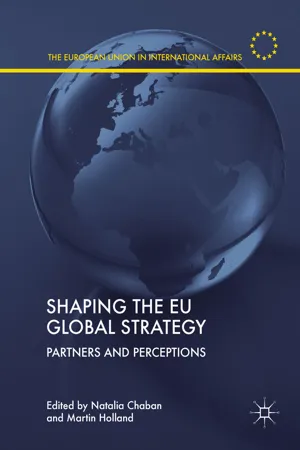The twenty-first century multipolar world presents a new context for international relations. The evolving shift of power in global governance —‘from the West to the rest’ and from state to non-state actors—has witnessed the emergence of a new array of competing players. At the same time, the EU’s volatile neighbourhood and continuing crises inside the Union have presented an unprecedented challenge to the EU’s reputation in the world. This Volume Shaping the EU Global Strategy : Partners and Perceptions ” considers the EU’s response to these fundamental global shifts in power and multiple internal challenges; it critically examines the global influence of the EU’s identity and values in the face of competing normative paradigms each with their own distinct policies and identities. This Volume argues that answers to these questions cannot be found simply by looking at the policies and identities as projected by the Union. Rather, the analysis focuses on the receivers of the EU’s messages and argues that reception is the key to a better understanding of the contemporary influence of the Union in a changing world.
In its search to define its own foreign policy identity for the twenty-first century, the EU has identified ten countries as strategic partners . Spanning four continents, these ten—the BRICS together with the US, Canada , Japan , South Korea and Mexico —are of profound significance to the EU: in economics, politics, security and global governance . To complement this, in June 2016 the EU launched its new Global Strategy to replace the previous 2003/2008 European Security Strategy perspectives. This publication directly informs, as well as is informed by, these contemporary realities. In 2015, the editors and contributors to this Volume were commissioned by the European External Action Service to undertake research on the perceptions held towards the EU in these ten strategic partner countries. The findings of this project have helped in some way both to inform the content and focus of the Global Strategy as well as provide the empirical basis for critical insight. As such, this Volume synergises policy relevance with rigorous academic analysis.
The empirical findings that underpin this analysis are from 2015, a year that confronted three EU crises: an unfolding migration crisis; a continuing Eurozone crisis ; and a crisis of solidarity best demonstrated through the Brexit debate. How these crises were viewed, interpreted and received by the media , decision-makers and general publics in the EU’s ten strategic partner countries is the focus of this Volume?
In light of the ‘significant role of social-psychological, cultural and ideological forces in the daily conduct of international affairs’ (Movahedi
1985), the Volume explores the
images and perceptions of the EU in the eyes of these ten
strategic partners . In changing multilateral settings,
images are postulated to be an influential factor behind the behaviour and foreign policy choices of actors. This approach rests on the established premise that ‘
reputation , the reflection of the reality of
power in the mind of the observers can be as important as the reality of
power itself. What others think about us is as important as what we actually are’ (Morgenthau
1965). In this context, a series of questions are addressed.
How do the ten strategic partners perceive the impact of the global shifts in power on the EU?
Is the EU perceived as coping well with the changing distribution of global power and its simultaneous internal crises?
How is the EU’s image changing?
What new narratives are emerging about the EU around the world?
How have these altered external images and narratives influenced EU policy frameworks (such as the June 2016 Global Strategy)?
How will the EU respond? Does it listen?
What is the future of the Strategic Partnership instrument?
In search of answers, contributions to this Volume are theoretically informed by a synergy of three theoretical paradigms: international relations (image theory ), studies of stereotypes (Othering ) and communication studies (cascading activation framing theory ). Geography acts as the organising principle, and each country Chapter is clear in its conceptual message that cognitive and emotional biases towards the EU are grounded in location- and political culture -specific contexts. Thus each Chapter adopts a common premise that EU images are the products of several interacting influences, namely factors: (1) that exist only in a specific location (e.g. national governments, local political systems, distinct societies) and are not linked to the EU’s actions; (2) that are EU specific and not controlled by the location in question; (3) that are global and exert influence through international systems; and finally, (4) that are linked to the EU-location interaction. As strategic partners , each of the ten countries engages in active dialogue with the EU in a variety issue-specific areas both at bi- and multilateral levels.
To address the inherent complexity of images in international relations, this Volume confines its assessment of the EU’s images to two main EU public diplomacy discourses—public opinion and media framing, with elite opinion playing just a minor complementary role. A systematic comparative methodology—between and within the ten strategic partner countries—is employed to identify biases and location-specific peculiarities.
1.1 Strategic Partners and Global Strategy
One of the EU’s tools that shapes diplomatic relations is the Strategic Partnership instrument, a contemporary policy response to better position the EU in a globalized world (Gratius 2013, p. 1). A group of established and emerging powers were identified by the EU as key strategic partners —four in the Americas (the US, Canada , Mexico and Brazil), five in the Asia-Pacific /Eurasia (Japan , South Korea , Russia , India and China ) and one in Africa (South Africa ). The European Security Strategy of 2003 was first to identify China , India , Japan , Russia and the US as the EU’s strategic partners (Cîrlig 2012, pp. 1–2). The list was subsequently extended to include South Africa , Brazil, South Korea, Can...
